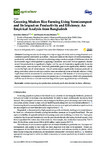Greening Modern Rice Farming Using Vermicompost and Its Impact on Productivity and Efficiency: An Empirical Analysis from Bangladesh
| dc.contributor.author | Rahman, Sanzidur | |
| dc.contributor.author | Barmon, BK | |
| dc.date.accessioned | 2019-11-19T19:55:57Z | |
| dc.date.available | 2019-11-19T19:55:57Z | |
| dc.date.issued | 2019-11-10 | |
| dc.identifier.issn | 1412-4262 | |
| dc.identifier.issn | 2077-0472 | |
| dc.identifier.other | ARTN 239 | |
| dc.identifier.uri | http://hdl.handle.net/10026.1/15169 | |
| dc.description.abstract |
<jats:p>Greening modern rice farming while improving productivity and reducing chemical use is a desirable goal for sustainable agriculture. This paper analyzes the impact of vermicomposting on productivity and efficiency of modern rice farming using a random sample of 340 farmers from the southwestern region of Bangladesh by applying a stochastic production frontier approach. Results reveal that productivity is significantly higher and the use of chemicals is significantly lower for vermicompost users as expected. However, profitability gain is not significantly different mainly due to the high cost of vermicompost. Use of vermicompost significantly increases productivity along with other conventional inputs and its users are relatively more technically efficient. Policy implications include investments to raise farmers’ awareness of the benefits of vermicomposting and support entrepreneurs to expand commercial production of vermicompost, which will synergistically curb the use of chemicals in modern rice farming while improving productivity and efficiency.</jats:p> | |
| dc.format.extent | 239-239 | |
| dc.language | en | |
| dc.language.iso | en | |
| dc.publisher | MDPI AG | |
| dc.subject | vermicomposting | |
| dc.subject | rice production | |
| dc.subject | stochastic production frontier | |
| dc.subject | technical efficiency | |
| dc.title | Greening Modern Rice Farming Using Vermicompost and Its Impact on Productivity and Efficiency: An Empirical Analysis from Bangladesh | |
| dc.type | journal-article | |
| dc.type | Journal Article | |
| plymouth.author-url | https://www.webofscience.com/api/gateway?GWVersion=2&SrcApp=PARTNER_APP&SrcAuth=LinksAMR&KeyUT=WOS:000500025800009&DestLinkType=FullRecord&DestApp=ALL_WOS&UsrCustomerID=11bb513d99f797142bcfeffcc58ea008 | |
| plymouth.issue | 11 | |
| plymouth.volume | 9 | |
| plymouth.publication-status | Published online | |
| plymouth.journal | Agriculture | |
| dc.identifier.doi | 10.3390/agriculture9110239 | |
| plymouth.organisational-group | /Plymouth | |
| plymouth.organisational-group | /Plymouth/Faculty of Arts, Humanities and Business | |
| plymouth.organisational-group | /Plymouth/Users by role | |
| dcterms.dateAccepted | 2019-11-07 | |
| dc.rights.embargodate | 2019-12-7 | |
| dc.identifier.eissn | 2077-0472 | |
| dc.rights.embargoperiod | Not known | |
| rioxxterms.versionofrecord | 10.3390/agriculture9110239 | |
| rioxxterms.licenseref.uri | http://www.rioxx.net/licenses/all-rights-reserved | |
| rioxxterms.licenseref.startdate | 2019-11-10 | |
| rioxxterms.type | Journal Article/Review |


